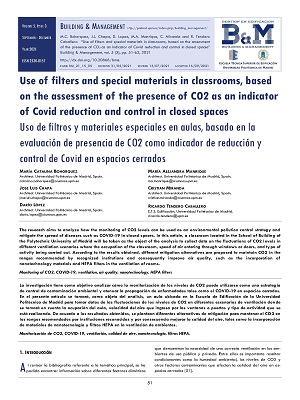
Use of filters and special materials in classrooms, based on the assessment of the presence of CO2 as an indicator of Covid reduction and control in closed spaces = Uso de filtros y materiales especiales en aulas, basado en la evaluación de presencia de CO2 como indicador de reducción y control de Covid en espacios cerrados
DOI: https://doi.org/10.20868/bma.2021.3.4714
Texto completo:
PDFResumen
Abstract
The research aims to analyze how the monitoring of CO2 levels can be used as an environmental pollution control strategy and mitigate the spread of diseases such as COVID-19 in closed spaces. In this article, a classroom located in the School of Building of the Polytechnic University of Madrid will be taken as the object of the analysis to collect data on the fluctuations of CO2 levels in different ventilation scenarios where the occupation of the classroom, speed of air entering through windows or doors, and type of activity being carried out. According to the results obtained, different mitigation alternatives are proposed to maintain CO2 in the ranges recommended by recognized institutions and consequently improve air quality, such as the incorporation of nanotechnology materials and HEPA filters in the ventilation of rooms.
Resumen
La investigación tiene como objetivo analizar cómo la monitorización de los niveles de CO2 puede utilizarse como una estrategia de control de contaminación ambiental y atenuar la propagación de enfermedades tales como el COVID-19 en espacios cerrados. En el presente artículo se tomará, como objeto del análisis, un aula ubicada en la Escuela de Edificación de la Universidad Politécnica de Madrid para tomar datos de las fluctuaciones de los niveles de CO2 en diferentes escenarios de ventilación donde se tomará en cuenta la ocupación del aula, velocidad del aire que ingresa por las ventanas o puertas y tipo de actividad que se está realizando. De acuerdo a los resultados obtenidos, se plantean diferentes alternativas de mitigación para mantener el CO2 en los rangos recomendados por instituciones reconocidas y por consecuencia mejorar la calidad del aire, tales como la incorporación de materiales de nanotecnología y filtros HEPA en la ventilación de ambientes.
Palabras clave
Referencias
Anderson, E. L., Turnham, P., Griffin, J. R., & Clarke, C. C. Consideración de la transmisión de aerosoles para COVID-19 y salud pública.
Bogdanović, U., Lazić, V., Vodnik, V., Budimir, M., Marković, Z., & Dimitrijević, S. (2014). Copper nanoparticles with high antimicrobial activity. Materials Let-ters, 128, 75-78.
Campos, E. V., Pereira, A. E., De Oliveira, J. L., Carvalho, L. B., Guilger-Casagrande, M., De Lima, R., & Fraceto, L. F. (2020). How can nanotechnology help to combat COVID-19? Opportunities and urgent need. Journal of Nanobiotechno-logy, 18(1), 1-23.
Cox, C. S., & Wathes, C. M. (1995). Bioaerosols handbook. Boca Raton: Lewis Publishers.
CRUZ, M., QUEROL, X., FELISI, M., GARRIDO, T. 2020. Guía para ventilación en aulas, Instituto de Diagnóstico Ambiental y Estudios del agua, IDAEA-CSIC, Mesura.
Duan, X., Liu, S., Huang, E., Shen, X., Wang, Z., Li, S., Jin,C. (2020) Super-hydrophobic and antibacterial wood enabled by polydopamine-assisted decoration of copper nanoparticles. Colloids and Surfaces A: Physicochemical and Engineering Aspects, 602, 125145.
Esteban-Tejeda, L., Malpartida, F., Esteban-Cubillo, A., Pecharromán, C., & Moya, J. S. (2009). Antibacterial and antifungal activity of a soda-lime glass contai-ning copper nanoparticles. Nanotechnology, 20(50), 505701.
Li, Z., Wei, F., & Liu, W. (2011, May). Manufacture of building blocks of humidity-controlling composite materials used in greenhouse. In 2011 International Confe-rence on Materials for Renewable Energy & Environment (Vol. 2, pp. 1125-1128). IEEE.
Lidwell, O. (1990). The microbiology of air. London: Edward Arnold. Vishal Chaudhary, Abhishek Royal, Murthy Chavali, S. K. Yadav. (2021) Advancements in research and development to combat COVID-19 using nanotechnology202110.1007/s41204-021-00102-7 Nanotechnology for Environmental Engineering.
Hatcher, J. (2020) Carbon Dioxide monitoring to lower the coronavirus threat. Smart Buildings Magazine.
Ordovás, J. M., Esteban, M., García-Retamero, R., González López Valcárcel, B., Gordaliza, A., Inzitari, M., ... & Luis Aduriz, A. (2020). Informe sobre COVID-19 en espacios interiores, en particular restaurantes
PAJUELO, L., 2021. Los mejores purificadores para limpiar el aire del hogar de alérgenos y otros virus. El País.com. https://elpais.com/elpais/2020/12/21/escaparate/1608563347_515506.html
Pecho, P., Škvareková, I., Ažaltovič, V., & Hrúz, M. (2020). Design of air circuit disinfection against COVID-19 in the conditions of airliners. Transportation Re-search Procedia, 51, 313-322.
Pelliccia, G., Baldinelli, G., Bianconi, F., Filippucci, M., Fioravanti, M., Goli, G., ... & Togni, M. (2020). Characterisation of wood hygromorphic panels for relative humidity passive control. Journal of Building Engineering, 32, 101829.
Tang, J. W., Li, Y., Eames, I., Chan, P. K. S., & Ridgway, G. L. (2006). Factors involved in the aerosol transmission of infection and control of ventilation in healthcare premises. Journal of Hospital Infection, 64(2), 100-114.
Carbon Dioxide monitoring to lower the coronavirus threat. (2020) Smart Building Magazine
REHVA COVID-19 guidance document How to operate HVAC and other building service systems to prevent the spread of the coronavirus (SARS-CoV-2) disease (COVID-19) in workplaces. Abril 2021.
GÓRNY, Rafał L., et al. Fungal fragments as indoor air biocontaminants. Applied and environmental microbiology, 2002, vol. 68, no 7, p. 3522.
Enlaces refback
- No hay ningún enlace refback.
Copyright (c) 2021 Autor / BY-NC-ND

Este obra está bajo una licencia de Creative Commons Reconocimiento-NoComercial-SinObraDerivada 4.0 Internacional.










